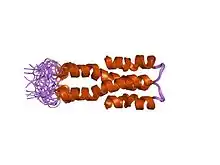Histone-like nucleoid-structuring protein
In molecular biology, the histone-like nucleoid-structuring (H-NS) protein belongs to a family of bacterial proteins that play a role in the formation of nucleoid structure and affect gene expression under certain conditions.[1] The protein has a homologue that is encoded by many large, conjugative plasmids.[2]
| H-NS histone family | |||||||||
|---|---|---|---|---|---|---|---|---|---|
 solution structure of the oligomerization domain of the bacterial chromatin-structuring protein h-ns | |||||||||
| Identifiers | |||||||||
| Symbol | Histone_HNS | ||||||||
| Pfam | PF00816 | ||||||||
| InterPro | IPR001801 | ||||||||
| SCOP2 | 1hns / SCOPe / SUPFAM | ||||||||
| |||||||||
Mechanism
A major function of H-NS is to influence DNA topology. It is believed that H-NS achieves this by forming complexes with itself and binding to different sections of DNA, bringing them together.[3][4] Another major role of H-NS is to turn off the expression of genes. H-NS regulates gene expression by binding to AT rich DNA, which is a common feature of promoters, and of horizontally acquired genes.[5] Relief of suppression by H-NS can be achieved by the binding of another protein, or by changes in DNA topology which can occur due to changes in temperature and osmolarity, for example.[3]
H-NS can also interact with other proteins and influence their function, for example it can interact with the flagellar motor protein FliG to increase its activity.[6]
References
- Shindo H, Iwaki T, Ieda R, Kurumizaka H, Ueguchi C, Mizuno T, Morikawa S, Nakamura H, Kuboniwa H (February 1995). "Solution structure of the DNA binding domain of a nucleoid-associated protein, H-NS, from Escherichia coli". FEBS Lett. 360 (2): 125–31. doi:10.1016/0014-5793(95)00079-O. PMID 7875316. S2CID 44479751.
- Beloin, C.; Deighan, P.; Doyle, M.; Dorman, C. J. (2003-10-01). "Shigella flexneri 2a strain 2457T expresses three members of the H-NS-like protein family: characterization of the Sfh protein". Molecular Genetics and Genomics: MGG. 270 (1): 66–77. doi:10.1007/s00438-003-0897-0. ISSN 1617-4615. PMID 12898223. S2CID 305597.
- Dorman, Charles J. (May 2004). "H-NS: a universal regulator for a dynamic genome". Nature Reviews Microbiology. 2 (5): 391–400. doi:10.1038/nrmicro883. PMID 15100692. S2CID 7772634.
- Dame, RT; Wyman, C; Goosen, N (15 September 2000). "H-NS mediated compaction of DNA visualised by atomic force microscopy". Nucleic Acids Research. 28 (18): 3504–10. doi:10.1093/nar/28.18.3504. PMC 110753. PMID 10982869.
- Lucchini, Sacha; Rowley, Gary; Goldberg, Martin D.; Hurd, Douglas; Harrison, Marcus; Hinton, Jay C. D. (2006). "H-NS Mediates the Silencing of Laterally Acquired Genes in Bacteria". PLOS Pathogens. 2 (8): e81. doi:10.1371/journal.ppat.0020081. PMC 1550270. PMID 16933988.
- Donato, Gina M.; Kawula, Thomas H. (11 September 1998). "Enhanced Binding of Altered H-NS Protein to Flagellar Rotor Protein FliG Causes Increased Flagellar Rotational Speed and Hypermotility in". Journal of Biological Chemistry. 273 (37): 24030–24036. doi:10.1074/jbc.273.37.24030. PMID 9727020.
